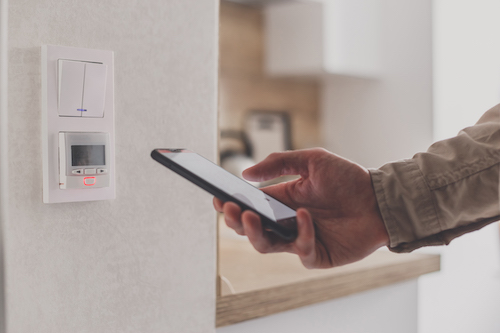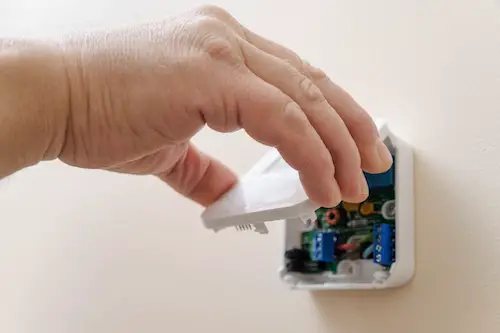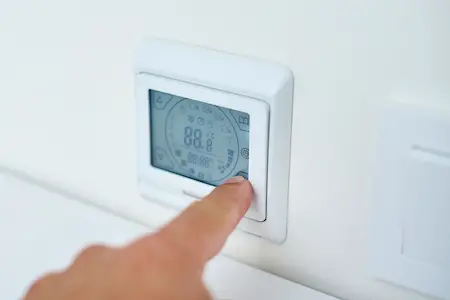Location, location, location!

That’s often the kicker when you are buying a house, but it’s just as important when you are choosing the right spot to place a thermostat in your home.
Correct thermostat placement is not just crucial for efficient heating; it ensures that you do not spend any more than you have to on utility bills. Wrong thermostat placement not only makes your home uncomfortable, but it also increases your bills.
Looking for Easy to Install Thermostat?
If you are after a thermostat that you can install on your own without professional help.
You can even preset your holiday dates and come back to a warm home.
Check for Current Price of This Easy to Install Home Thermostat
Due to the apparent fact that two-storey houses come with upstairs and downstairs, placing the thermostat in the right location can be a tad worrisome. Why? Some parts of the house, mainly the upstairs, are often cooler than the rest. And, depending on the weather condition of any given time, this could be favourable or problematic.
With that in mind, and working with the knowledge that hot air rises, while cold air sinks – the best place to place your thermostat would be in a central location in your house.
So what factors should you consider when looking for the best location for a thermostat in a two-storey house?
-
Approximately 5 Feet Off the Floor
That is because heat rises, so putting the thermostat any higher could cause the thermostat to pick up too much heat. As you place it five feet off the floor, make sure that it’s away from any windows, vents, doors and away from any direct sunlight. There are reasons for this:
For one, if you place your thermostat close to direct sunlight, the odds of the thermostat picking up inaccurate readings are very high. Direct sunlight equals heat, so naturally, your thermostat will pick up on this. That will be problematic for you because your thermostat will not be able to react appropriately to the temperature you need at any given time.

Also, if you place your thermostat close to the window, you could experience the same thing. The thermostat could react to the constant opening and closing of the door, causing the temperature to fluctuate. Again, this will make the thermostat unable to respond correctly to your desired temperature.
Another thing is that if the temperature fluctuates, causing the thermostat to randomly switch between blowing hot air and cold air, it could potentially ruin it.
Again, placing your thermostat above air vents is just as bad if not worse. If the thermostat is placed there, it essentially gets hit with cold and hot air, making it very hard to read the actual temperature.
-
On an Interior Wall
The thermostat is specifically designed to read the temperature of your home and react to it, placing it on an interior wall will ensure that this happens. An interior wall is often located in the most average part of the house, and this could be the family room or the living room.
The significant advantage of this is that the family or living room is the most used part of the house, making it perfect because this is where you want the temperature to be most controlled as it gives an accurate depiction of your home’s average temperature at any given time.
Placing the thermostat on an external wall is not a good idea. That is because external walls are often cooler, and this could make the thermostat give inaccurate readings.
-
In a Central Location
A central location could refer to the most used room in your house. That is almost the same as placing the thermostat on an interior wall.

One thing you want to avoid is putting your thermostat in a room that is infrequently used. That is essentially a waste because the thermostat would be reacting to the temperature of a room that you don’t use while ignoring the ones that you do use.
Should I Get Two thermostats?
It’s a two-storey house, so this is a fair consideration, and some homes do operate on two thermostats. However, if you place the thermostat in the right location, you wouldn’t need two.
Should I Move My Thermostat?
Well, this is no small feat as you will be dealing with wirings and the likes. However, if the current location of your thermostat is not giving you the desired result, then, of course, you should move it. There are professionals out there who can handle it.
However, if instead of moving the thermostat, you are thinking about replacing it, then you should go for a thermostat with two controls.
When it comes to setting the temperature of a two-storey home, some people think that setting the top floor and down floor at the same temperature is the best way to go, but it is not.
You should always set the top floor temperature at your desired temperature and set the down floor temperature at two degrees lower.
For instance, during the heat, when you have the AC running, you can set the top floor at your preferred house temperature, and you can set the down floor, two degrees warmer.
The reason for this is that the down floor is usually warmer, which means the heat will rise, which will, in turn, create a comfortable balance for your home. So, at this point, the top floor needs all the help it can get. So, if you have the top floor at say 24 degrees, you can have the down floor at 22 degrees.
If you set both floors at the same temperature, one floor will likely be warmer or colder than the other.
You can do the opposite of this during the winter.
Note that, cranking the temperature of your thermostat up or down during the heat or cold could lead to potential problems. That will not only potentially damage your thermostat, but it will also increase your utility bills.
With a single storey home, you are not burdened by any of this, so it all depends on what you are most comfortable it. However, according to a recommendation by the World Health Organization, the average UK home should during the winter have a room temperature of 18 degrees to 21 degrees.
This recommendation aids the battle with climate change, so it is not such a terrible idea.

